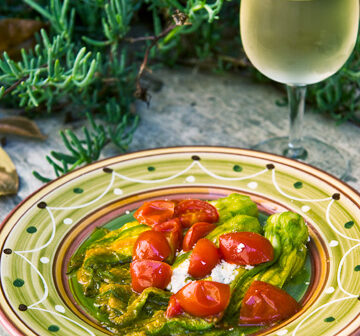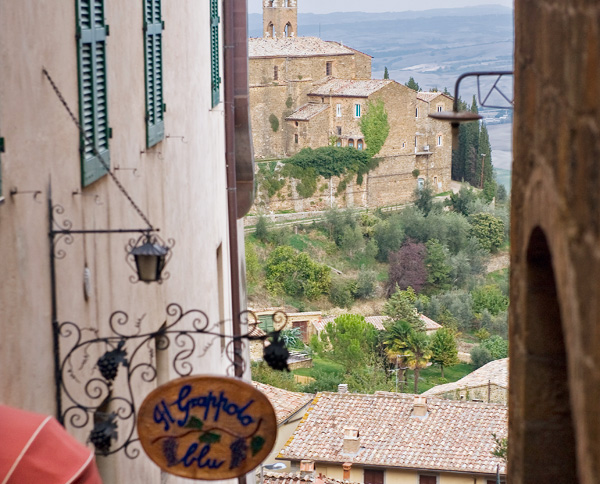
In the United States, eating locally grown products in seasonal rotation is a timely trend. In Tuscany, it’s the only approach to eating that anyone has ever known. Instead of attempting to see as much of Italy as we could in a week, our group decided to take it slow and immerse ourselves in the food, wine, politics, history, and culture of a small area of Tuscany.
For seven days, we lived in Casa dei Pipistrelli, a restored 17th-century, five-bedroom home with an adjoining two-bedroom guesthouse located eight miles south of Siena in Montestigliano. To reach the private villa, you drive up a two-mile unpaved road lined with towering cypress and oak trees. The villa sits on the crest of the Montagnola Senese hills and overlooks the estate’s 2,500 acres. The owners of the property still operate a working farm on the land. Groves of olive trees yield to meadows filled with wildflowers. Thick forests of towering hickory and oak provide the perfect conditions for truffles and porcini mushrooms to thrive beneath the canopy. During the summer months, the farm grows sugar beets, corn, and wheat; in the fall, they press olive oil.
We spent our early mornings at Pipistrelli sipping strong coffee and watching a thick, low fog move across the hills. But once we heard the sound of Gina’s car barreling up the long drive, we scattered to grab our bags. This woman is a yellow-haired tornado, and when she says “be ready by 9:30,” you best be ready at 9:30.
Ecco la Cucina’s classes are taught in the villa’s spacious kitchen or in a somewhat commercial kitchen in a charmingly restored 12th-century mill a few miles away. Our first class took place under the curved stone ceiling and walls of the mill. We strapped on our aprons and gathered around the ingredients arranged like a still life painting waiting to happen. Huge bunches of freshly picked sage, baskets of yellow zucchini blossoms and chestnuts, clumps of Sangiovese grapes, tiny quails, shallots, butter, olive oil—it all sat before us waiting to be whipped into Tuscan masterpieces.
The culinary talent of our eclectic group—Karen, Sherry, Jeannie, Nancy, Eric, Evan, Dick, and A.W.—was varied. While Eric and Evan have rarely handled a chef knife, Karen is a respected chef and has owned her own restaurant and catering company.
Once the recipes were passed out, we divided into groups. Then Gina the tour guide turned into Gina the chef. To say Gina is passionate about all things Italian is a gross understatement. When she stands in front of a class with her tightly curled hair tied back loosely, her body and hands never stop “talking.” When she speaks, she demands your attention. She is obsessive, fanatical, hot-blooded, intimidating, and adoring. Most important, her zeal is contagious.
After a prep talk, Eric and Evan decided to tackle making biscotti. Dick and A.W. plucked and carved the quail. Karen and I stuffed zucchini flowers with locally produced goat cheese while Sherry and Jeannie made the ricotta chestnut filling for the ravioli. When it came time to make the pasta, we all gathered around Gina as she dumped six cups of flour on the table, scooped out the center, and dropped in six eggs. “Now, who has two good stirring fingers?” she asked. Evan stepped up to the table and whipped his fingers in circles through the flour like he knew what he was doing. A few minutes later, the eggs and flour thickened into a ball. Once kneaded, we took turns rolling the dough through the pasta machine.
The ricotta chestnut filling that wasn’t devoured straight from the pan was scooped out in tablespoon-sized dollops and dropped on the pasta. Another layer of pasta was laid on top before we cut out the ravioli with a mold.
Gina didn’t let us stop and take in the aromas of baking biscotti and quail simmering in Sangiovese sauce; it was time to set the table. Even though it was mid-October, the weather was cool and crisp. Our outdoor dining table overlooked the property’s organic vegetable garden. We sipped local wines and feasted on our labors. We gave thanks to the elastic in the waist of our pants.
Fighting off the urge to nap, we headed to Siena for a walking tour. Set on three hills, the city is a circuitous series of winding alleyways, streets, and steep steps. At the heart is the Piazza del Campo famed for the Palio, the historic—and what some people outside Siena consider insane—horse races that take place each year. We stood in the Piazza del Campo and watched the sun set behind the Torre del Mangia and pushed our caloric intake into five digits. You can’t have a day in Tuscany without at least two scoops of double chocolate and pistachio gelato.
This Little Piggy
The following morning we headed out for an agri-tourist’s dream day. Our first stop was a Cinta Senese pig farm operated by Daniele Baruffaldi. The pigs, distinctively different from other breeds, are black with a white belt (cinta). The front legs are pink; the back legs are black. Their snouts are long, perfect for foraging. Their big ears may look funny, but they flop over their eyes and protect them as they root through the forest.
This native breed has been in Tuscany since the 14th century but was nearly extinct by the 1980s. The Cinta Senese is a slow grower and is always raised in semi-wild conditions. Farmers eager to increase production switched to raising breeds that grow in half the time and have adapted to feed and the crowded conditions of pigsties. By industrializing pig production, farmers produced more and leaner pork, but they nearly lost the Cinta Senese pig in the process.
Twenty years ago, a consortium of pig producers started a local movement to reintroduce the Cinta Senese. Thanks to the board, combined with the efforts of the Slow Food movement and the growth of agri-tourism (travelers who take the time to visit small farms and support rural farming efforts), the Cinta Senese is making a comeback.
The meat from the Cinta Senese is tastier than conventionally raised pigs because it’s high in fat, but it’s also high in omega-3 and antioxidants. (Translation: it’s good for you.) And it’s good. The meat melts in your mouth and releases the distinctive flavors of the acorns, wild tubers, roots, and truffles ingested by the pigs.
As we walked through Daniele’s olive trees (he is also an olive oil producer and professional taster), he cupped his hands together and called “ ’Niamo, ’niamo.” Suddenly, 150 pigs—some weighing almost 500 pounds—come running out of the bushes. Daniele, who speaks no English, hugged his pet pig, Bella. “They are more loyal than dogs,” he said. “And they eat healthier than we do.” While the pigs squealed for handouts, Daniele related the history of the Cinta Senese as Gina interpreted.
Then Gina spotted what Daniele calls a “Chin-Chin,” a piglet produced when a free-roaming Cinta Senese sow hooks up with a wild boar. Chin-Chin is a rare delicacy in Tuscany—so rare you never see it in a market or restaurant. “I’ve been working with Daniele for five years,” said Gina. “He won’t sell it to me or even let me taste it.” It’s a pig farmer’s secret and usually saved to be consumed on special occasions by family.






